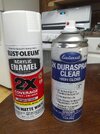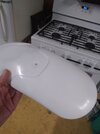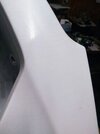What the heck am I doing wrong ? Im trying to paint the motorcycle and want a matte white clear coat finish. I used the two products pictured, I first prepped the surfaces. Then painted it with the Matte white paint, let it dry for 2 days then hit it with 2 coats of the Eastwood 2K gloss clear . Let it dry for two weeks and then used a 1500 grit buff pad to cut the shine. The result was what I expected on the front fender as you can see. I then did the seat section in the same exact way and time line, all was looking good until just today attempted to take the shine off with the same 1500 grit pad and these cracks showed up in the paint. What the heck happened ?









